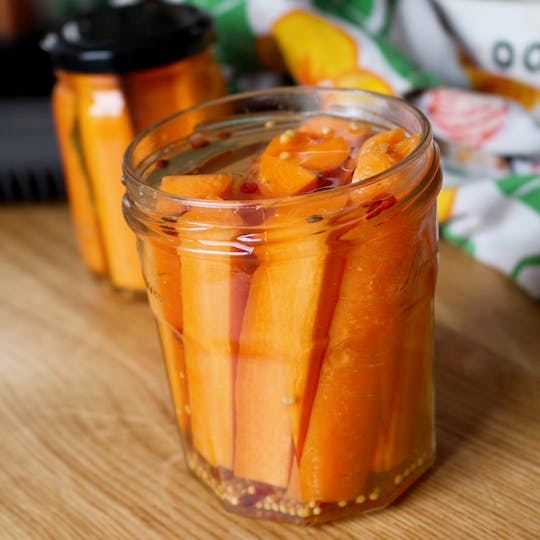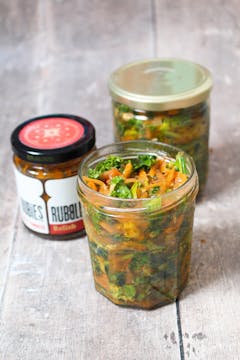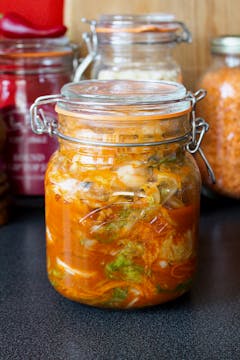Learn How To Ferment Vegetables
Finding yourself with too much veg to use up? Instead of leaving them to wither away at the bottom of your fridge, why not learn how to ferment vegetables!

We could go on about the benefits of fermenting food for days - not least because it’s a great way to save any spare or slightly overripe fruit and veg from ending up in the bin.
Fermentation is an age-old preservation technique and a wonderful way of adding variety back into your meals. What’s more, fermented foods are packed with ‘good’ bacteria that can help boost your gut health and improve digestion.
What is lacto-fermentation?
Lacto-fermentation is one of the oldest and most common methods of fermentation that’s used by many different cultures all over the world. Lacto-fermented foods are everywhere, too, and include everything from yoghurt to kimchi.
It may seem odd, but not all bacteria is bad for you. There’s plenty of ‘good’ bacteria with properties that can help maintain the health of your tummy. This includes lactobacillus, a bacteria present in most fruit and veg.
During lacto-fermentation lactobacillus breaks down sugar into lactic acid. This then acts as a natural preservative and gives your veg that lovely, tangy, fermented flavour. Lactic acid also helps food retain its natural flavours and beneficial nutrients.
Salt is typically added during lacto-fermentation to speed up the process and get rid of any bad bacteria lurking in your veg.
What are some examples of fermented vegetables?
Kimchi and sauerkraut are the most popular fermented foods that come to mind. Both are typically made from cabbage and are tasty, tummy-loving alternatives to more typical side dishes like boiled or roasted veg. Pickle is another example which can be made from all kinds of fruit and veg.
There are many different types of fermented vegetables, some of which you’ll definitely have come across - if not eaten! - in the past. Recognise any of these?
- Kombucha
- Kefir
- Miso
- Tempeh
These are all brilliant fermenting foods, too.
What do I need to ferment vegetables?
Keen to have a go at fermenting at home? There are a few must-have items that will help make the process a little bit easier:
- Sterilised jars in a variety of different sizes.
- Salt - you can either salt your veg and let it ferment in its own juices or create a brine.
- Vegetables from your fridge or cupboards.
Note that you can alternatively use whey or a starter culture to ferment your food. It’s also possible to seal your jars using clean muslin clothes and rubber bands rather than lids.
How to ferment vegetables
Feeling inspired to use up some of the veg in your box? Here’s how to make fermented vegetables from scratch using the simple brine method:
- Begin by thoroughly sterilising your chosen jar. Wash it with warm soapy water and dry it well. Next, place it in the oven for 15 minutes at 180°C/160°C fan.
- Prep your vegetables. Wash your veg and decide if you’ll slice, dice, shred or grate it. Received some tiny onions? You could even leave them whole.
- Make a brine. Mix 1 to 3 tbsp of salt into 950ml of water. How salty you make your brine will largely depend on personal preference. You’ll probably have to experiment to find the perfect balance.
- Add your veg to the jar. Arrange your veg loosely in the jar.
- Pour over the brine. Make sure the veg is covered with brine and then press it down gently to remove any bubbles of air. Screw the lid on tightly.
- Leave to ferment at room temperature. This should take around three days. You’ll want to open your jar once a day to check the brine level - top it up if the veg is no longer covered.
- Pop it in the fridge to finish fermentation. Once your veg has started to bubble and has a subtly sour scent, transfer it to the fridge. Leave it for up to a week before eating.
You can also add herbs, spices or seeds to your jar to give your fermented veg extra flavour. Check out our seven fave kimchi recipes for some brilliant seasoning examples.
What are the best vegetables to ferment?
You don’t just have to limit yourself to fermented cabbage. Carrots, beetroot, radish and cucumber are all ideal options. In fact, almost every kind of veg - and even some fruits - can be preserved through fermentation.
Why not get creative and try fermenting some of the more odd vegetables from your box? From fermented broccoli to fermented radish, the sky really is the limit! You can ferment fruit as well. Check out our list of delicious drinks you can make from fermented fruit scraps!
How long do fermented vegetables last?
Fermented vegetables have a pretty long shelf life. That’s why they’ve been a popular foodstuff for centuries (and long before we had fridges…)
Nevertheless, how long your fermented veg lasts will depend on your fermentation method and how you choose to store them. Typically, a jar of sauerkraut or pickle should last anywhere from four to 18 months when sealed tight and stored in the fridge.
Not sure if your fermented veg has reached its use-by date? Give it a sniff. If it has a very strong, unpleasant smell, it’s probably inedible. Fuzzy mould and a slimy texture are also two tell-tale signs of fermented veg that’s gone bad.
Fermentation isn’t the only way to make your veg last longer. Check out our top recipes for preserving veg for more inspiration.
Craving Some More Fermented Vegetable Recipes?
Check these out!

Vietnamese-Style Grilled Tofu Vegan Sandwich
Baguette stuffed with golden grilled tofu, sour fermented mooli radish and spicy vegan mayo.

Zero-Waste Preserved Kale
Ferment kale leaves and stems to make a spicy, crunchy preserve.Serve it on its own, in fritters, stews or with eggs.

Kilner Spicy Fermented Vegetables
Fermenting is a simple, tasty way to preserve food with added health benefits. Try fermenting your vegetables into this tangy and spicy sauce. You can get your hands on some Kilner Jars by visiting their website here.

